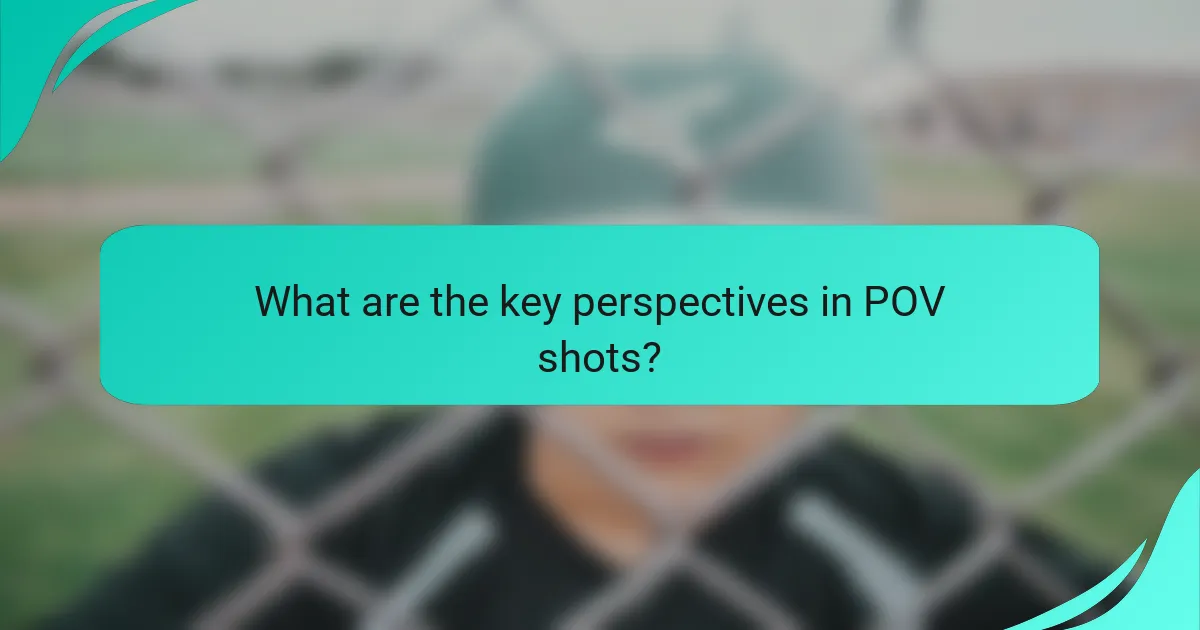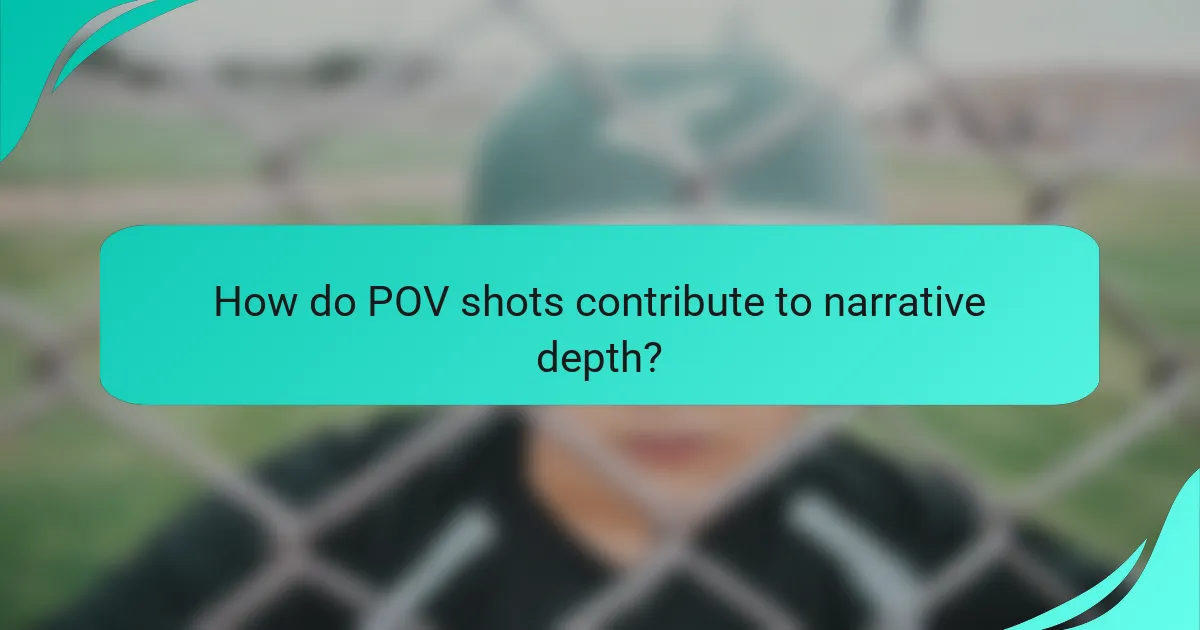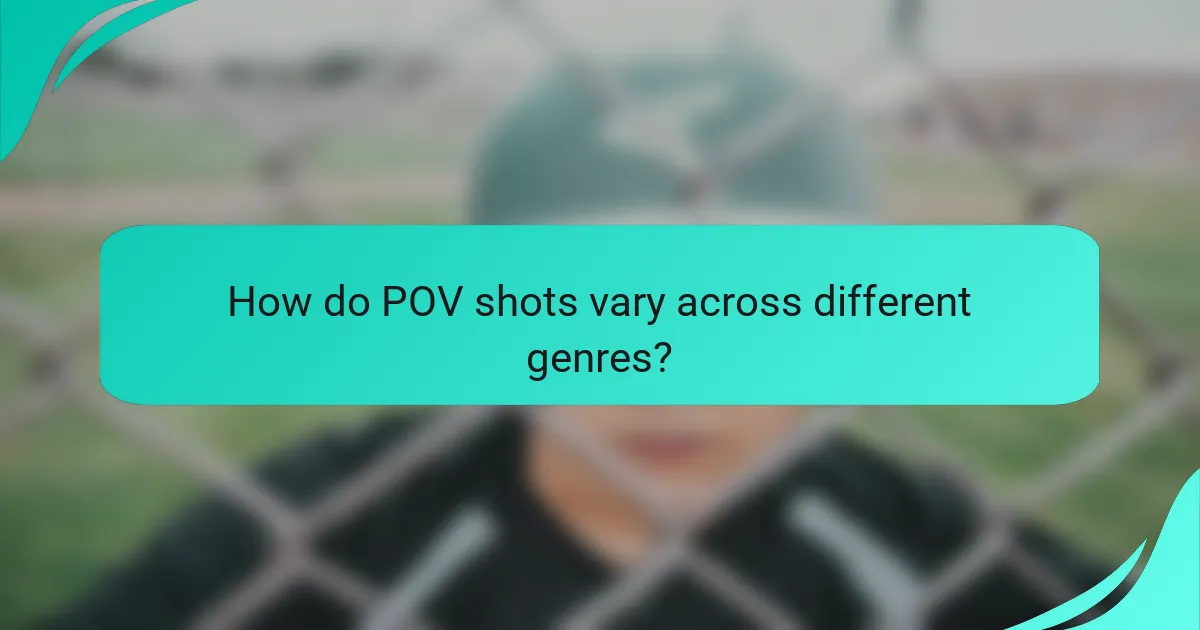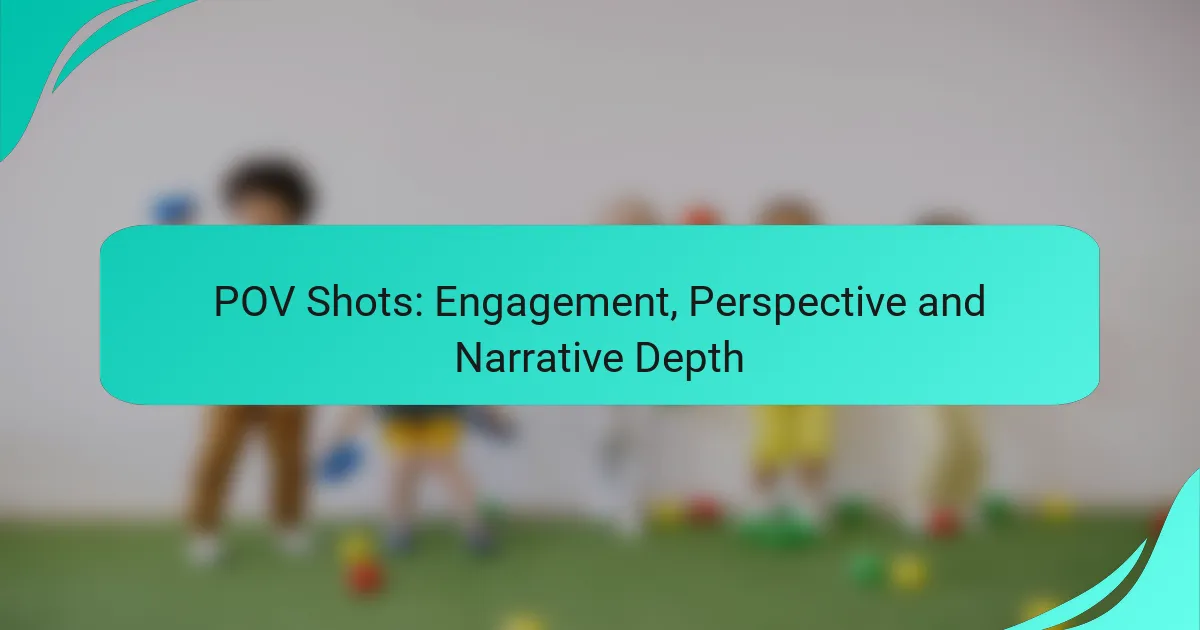POV shots are a powerful cinematic technique that enhances viewer engagement by allowing audiences to experience the narrative through a character’s eyes. By immersing viewers in a character’s emotions and perceptions, these shots create a more intimate connection with the story, enriching the overall viewing experience. Additionally, the use of first-person and third-person limited perspectives shapes how the narrative is perceived, deepening the audience’s understanding of the characters and their motivations.

How do POV shots enhance engagement in film?
POV shots enhance engagement in film by allowing viewers to experience the narrative through a character’s eyes, creating a more intimate connection with the story. This technique immerses the audience in the character’s emotions and perceptions, making the viewing experience more compelling and relatable.
Increased emotional connection
POV shots foster a stronger emotional bond between the audience and characters. By seeing the world from a character’s viewpoint, viewers can better understand their feelings and motivations, leading to heightened empathy. For instance, a character experiencing fear during a suspenseful scene can evoke a visceral reaction in the audience, as they share that perspective directly.
To maximize emotional impact, filmmakers should consider the character’s emotional state when framing POV shots. Using close-ups and dynamic angles can amplify the intensity of the moment, drawing viewers deeper into the character’s experience.
Immersive audience experience
POV shots create an immersive experience by placing viewers directly within the action. This technique allows the audience to feel as though they are part of the story, rather than just passive observers. For example, a chase scene filmed from a character’s perspective can evoke adrenaline and excitement, making the audience feel the urgency of the moment.
To enhance immersion, filmmakers can combine POV shots with sound design and visual effects that reflect the character’s sensory experiences. This approach can deepen the audience’s engagement and create a more vivid storytelling experience.
Character perspective alignment
POV shots align the audience’s perspective with that of the character, reinforcing their journey and decisions. This alignment helps viewers understand the character’s choices and the stakes involved, making the narrative more coherent and impactful. For instance, when a character faces a moral dilemma, seeing the situation through their eyes can clarify their internal conflict.
Filmmakers should strategically use POV shots to highlight key moments in the narrative where character perspective is crucial. This technique can guide audience interpretation and enhance the overall storytelling by emphasizing the character’s point of view during pivotal scenes.

What are the key perspectives in POV shots?
POV shots primarily involve two key perspectives: first-person and third-person limited. Each perspective shapes the viewer’s engagement and understanding of the narrative, influencing how the story is perceived and experienced.
First-person perspective
First-person perspective in POV shots immerses the audience directly into the character’s experience, allowing viewers to see through the character’s eyes. This technique creates a strong emotional connection, making the audience feel as if they are part of the action.
When using first-person POV, consider the impact of visual cues and sound design to enhance immersion. For example, shaky camera movements can simulate the character’s physical state, while close-ups can emphasize emotional reactions. Avoid overusing this perspective to prevent viewer fatigue.
Third-person limited perspective
Third-person limited perspective offers a broader view while still focusing on a single character’s thoughts and feelings. This approach allows the audience to understand the character’s motivations while maintaining some narrative distance, which can be useful for building tension.
In third-person limited POV shots, use framing and angles to convey the character’s emotional state without losing the overall context of the scene. For instance, a wide shot can establish the setting, while a close-up can reveal the character’s internal struggle. Balancing these perspectives can enhance narrative depth and viewer engagement.

How do POV shots contribute to narrative depth?
POV shots significantly enhance narrative depth by immersing the audience in a character’s perspective, allowing viewers to experience events through their eyes. This technique fosters a deeper emotional connection and understanding of the character’s motivations and experiences.
Character-driven storytelling
POV shots are essential in character-driven storytelling as they provide insight into a character’s thoughts and feelings. By showing the world from a specific character’s viewpoint, filmmakers can create a more intimate connection between the audience and the character. This approach helps to convey complex emotions and internal conflicts that might be lost in traditional narrative styles.
For example, a character facing a moral dilemma can be portrayed through POV shots that highlight their reactions and surroundings, allowing viewers to empathize with their struggle. This technique can be particularly effective in genres like drama and thriller, where character motivations are crucial to the plot.
Visual storytelling techniques
POV shots utilize various visual storytelling techniques to enhance the narrative. By framing scenes from a character’s perspective, filmmakers can manipulate the audience’s focus and create tension or suspense. This can be achieved through camera angles, movement, and depth of field, which emphasize what the character sees and feels.
Additionally, combining POV shots with sound design can further immerse the audience. For instance, incorporating the character’s heartbeat or breathing sounds can heighten emotional intensity. When executed well, these techniques can transform a simple scene into a powerful narrative moment, making the audience feel as if they are experiencing the story firsthand.

What are the best practices for using POV shots?
Effective use of POV shots involves creating a strong connection between the viewer and the character’s experience. To achieve this, filmmakers should focus on clarity, balance, and intentionality in their shot selection.
Maintaining clarity in perspective
Clarity in perspective is crucial for ensuring that the audience understands whose point of view is being represented. Use distinct framing and focus techniques to highlight the character’s emotions and reactions. For instance, a close-up of the character’s eyes can enhance the viewer’s connection to their experience.
Additionally, avoid overly complex camera movements that may confuse the viewer. Stick to straightforward pans or tilts that align with the character’s gaze to maintain coherence. This helps the audience stay engaged and immersed in the narrative.
Balancing POV with other shot types
While POV shots are powerful, they should be balanced with other shot types to create a dynamic visual narrative. Incorporating wide shots or over-the-shoulder angles can provide context and enhance storytelling. For example, transitioning from a POV shot to an over-the-shoulder view can reveal the environment and other characters, enriching the scene.
It’s essential to consider pacing when mixing shot types. Too many POV shots in succession can lead to fatigue, while a well-timed switch can refresh the viewer’s perspective. Aim for a ratio of about 1:3, where one POV shot is followed by three other types, to maintain engagement without overwhelming the audience.

What tools enhance POV shot creation?
Creating effective POV shots relies on various tools that enhance stability, immersion, and narrative depth. Key equipment includes camera stabilization devices and advanced virtual reality technology, both of which significantly improve the viewer’s experience.
Camera stabilization equipment
Camera stabilization equipment is essential for producing smooth and engaging POV shots. Devices such as gimbals and steadicams help eliminate unwanted shakes and jitters, allowing for fluid motion that mimics natural head movement.
When selecting stabilization gear, consider the weight of your camera and the type of shots you plan to capture. For handheld shooting, a lightweight gimbal is often ideal, while heavier setups may benefit from a steadicam rig. Always ensure that the stabilization equipment is compatible with your camera model.
Virtual reality technology
Virtual reality (VR) technology enhances POV shots by immersing viewers in a 360-degree environment. This technology allows audiences to experience scenes as if they are physically present, providing a unique perspective that traditional filming cannot achieve.
To effectively utilize VR for POV shots, invest in a good quality 360-degree camera and editing software that supports VR formats. Keep in mind that VR content requires careful planning of the environment and action to ensure that viewers remain engaged and oriented throughout the experience.

How do POV shots vary across different genres?
POV shots differ significantly across genres, as each utilizes this technique to enhance storytelling and viewer engagement. In horror, POV shots create tension and fear, while in documentaries, they provide authenticity and a personal connection to the subject matter.
Horror genre techniques
In horror films, POV shots are often used to immerse the audience in the perspective of the victim or the antagonist. This technique heightens suspense by allowing viewers to experience the fear and uncertainty firsthand. For example, a shaky camera following a character through a dark hallway can evoke a visceral sense of dread.
Common methods include using handheld cameras to create a sense of realism and urgency, as well as framing shots to obscure the full view of the threat, keeping viewers on edge. Filmmakers might also employ quick cuts between POV shots and wider angles to amplify the disorientation and panic felt by the characters.
Documentary style applications
In documentaries, POV shots serve to establish a personal connection between the audience and the subjects being portrayed. By using first-person perspectives, filmmakers can convey the emotions and experiences of individuals, making the narrative more relatable and impactful. For instance, a documentary about a social issue might include POV shots of individuals affected by that issue, allowing viewers to see the world through their eyes.
Techniques in this genre often involve steady, unobtrusive camera work to maintain authenticity. Filmmakers may also use interviews combined with POV shots to create a narrative that feels both informative and personal, drawing the audience deeper into the story being told.

What are the emerging trends in POV shot usage?
Emerging trends in POV shot usage highlight a shift towards more immersive storytelling techniques in film and video production. Filmmakers are increasingly adopting POV shots to enhance viewer engagement and create a deeper emotional connection with characters.
Increased Use of Technology
Advancements in camera technology have made it easier to capture POV shots with greater clarity and realism. Devices such as action cameras and drones allow filmmakers to experiment with dynamic angles and perspectives that were previously difficult to achieve. This technological evolution enables a more authentic representation of a character’s experience.
Interactive and Virtual Reality Experiences
With the rise of virtual reality (VR) and interactive media, POV shots are becoming integral to creating immersive environments. These formats allow users to experience narratives from a first-person perspective, leading to a more engaging and personalized storytelling experience. Filmmakers are exploring how to blend traditional POV techniques with interactive elements to enhance viewer involvement.
Emphasis on Emotional Connection
Filmmakers are increasingly using POV shots to foster emotional connections between characters and audiences. By placing viewers in the shoes of a character, the narrative becomes more impactful, allowing for a deeper understanding of motivations and emotions. This trend is particularly evident in genres such as drama and horror, where the psychological experience is crucial.
Short-Form Content and Social Media
As short-form content gains popularity on platforms like TikTok and Instagram, POV shots are being utilized to quickly convey stories and emotions. These brief clips often rely on the immediacy of a first-person perspective to capture attention and evoke reactions in a matter of seconds. This trend reflects the changing consumption habits of audiences who favor quick, engaging narratives.
